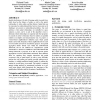350 search results - page 67 / 70 » Using Personality Factors to Predict Interface Learning Perf... |
MM
2006
ACM
14 years 1 months ago
2006
ACM
We used human movement as the basis for designing a collaborative aesthetic design environment. Our intention was to promote social interaction and creative expression. We employe...
SIGECOM
2010
ACM
14 years 9 days ago
2010
ACM
Product recommendation and decision support systems must generally develop a model of user preferences by querying or otherwise interacting with a user. Recent approaches to elici...
WWW
2009
ACM
14 years 8 months ago
2009
ACM
With the advent of Web 2.0 technologies, websites have evolved from static pages to dynamic, interactive Web-based applications with the ability to replicate common desktop functi...
CEC
2010
IEEE
13 years 8 months ago
2010
IEEE
An important challenge within hyper-heuristic research is to design search methodologies that work well, not only across different instances of the same problem, but also across di...
KDD
2009
ACM
14 years 8 months ago
2009
ACM
Spatial classification is the task of learning models to predict class labels based on the features of entities as well as the spatial relationships to other entities and their fe...


